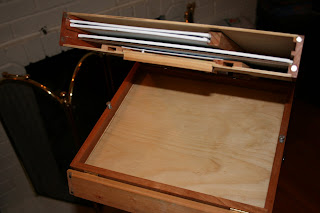
What's not to love about William Merritt Chase (self-portrait, left), one of the nineteenth (and twentieth) century's most important American painters and teachers in the Impressionist tradition?
Born in Indiana, Chase was the son of a local merchant. The family moved to Indianapolis in 1861. He showed early artistic talent and studied under local artists in his youth.
After a stint in the Navy Chase was encouraged to move to New York. Arriving there in 1869 he enrolled in the National Academy of Design. For financial reasons Chase left New York in 1870 for St. Louis, Missouri, where he became active in the art community. He exhibited his first painting at the National Academy in 1871 and drew the attention of wealthy collectors in St. Louis. Some of those collectors arranged for Chase to visit Europe for two years.
In Europe Chase attended the Academy of Fine Arts in Munich, studying under Alexander von Wagner and Karl von Piloty. While in Europe Chase focused primarily on figure painting. He later traveled to Venice, Italy, in 1877 with fellow artists Frank Duveneck and John Henry Twachtman, both friends from the Academy of Fine Arts.
In contrast to Tom Thomson (see March 18, 2009 post), it wasn't
all about
plein air for William Merritt Chase. No "shack by the lake" for him! By 1878 Chase was recognized as one of a number of new, and gifted, European-trained artists in the United States. In New York he opened a studio in the Tenth Street Studio Building, home to many important painters of the day. There he moved into Albert Bierstadt's old studio (more about Bierstadt in a future post), decorating it lavishly. Chase depicted his "inner studio" at Tenth Street in one of his paintings and it is truly remarkable -- fit for a sultan.
Chase was also a member of the Tilers, a group of artists and authors including such artistic notables as Winslow Homer, Arthur Quartley and Augustus Saint Gaudens. In addition to his painting prowess he was an urban sophisticate of the first order.

Chase was actively involved in teaching. He opened the Shinnecock Hills Summer School on eastern Long Island in 1891 and taught there until 1902. He adopted the
plein air method and often taught his classes outdoors. He opened the Chase School of Art (now the New York School of Art) in 1896 and taught there until 1907. He also taught at the Pennsylvania Academy of the Fine Arts, the Art Student League and the Brooklyn Art Association.
Chase the landscape painter is best known for two themes of subjects, both painted in an Impressionist style. The first were summer landscapes at Shinnecock (see, for example,
Shinnecock Hills I, above left), which are emblematic of American Impressionism at its zenith. The second were scenes of Prospect Park in Brooklyn and of Central Park in New York (see
On the Lake, Central Park, below right).

Chase's landscapes frequently feature people at leisure, especially women and children. When I'm in New York on a warm afternoon and find time for a walk through Central Park, I feel the presence of Chase. If you're ever there, try having breakfast in the dining room of the Helmsley Park Lane on Central Park South. Take in the view. You'll be channelling William Merritt Chase!
There's an elegance and sophistication to Chase's work that fairly leaps off the canvas. You find yourself standing a bit straighter having taken in one of his paintings. Along with Robert Henri (his rival) Chase was the most important teacher of artists in the United States at the turn of the twentieth century -- his students included Charles Demuth, Marsden Hartley, Georgia O'Keefe and Edward Charles Volkert.
For more information I highly recommend the William Merritt Chase Virtual Gallery at:
http://www.william-merritt-chase.org/. It's a beautiful collection of Chase's work and includes valuable information about his life and artistic career. The images in this post are courtesy of the Virtual Gallery. I am also indebted to the Virtual Gallery for much of the biographical information in this post. Thank you, Virtual Gallery, and thank you, William Merritt Chase!
 I resolved not to do another blog post until I had another of my own paintings to share. No sooner had I made this resolution than the weather went downhill. I'm not a "hardcore" plein air painter (you know -- painting in a hail storm with the medium turning to frozen jelly) so I waited it out. Yesterday it was nice and I found time to get outside and paint.
I resolved not to do another blog post until I had another of my own paintings to share. No sooner had I made this resolution than the weather went downhill. I'm not a "hardcore" plein air painter (you know -- painting in a hail storm with the medium turning to frozen jelly) so I waited it out. Yesterday it was nice and I found time to get outside and paint.















